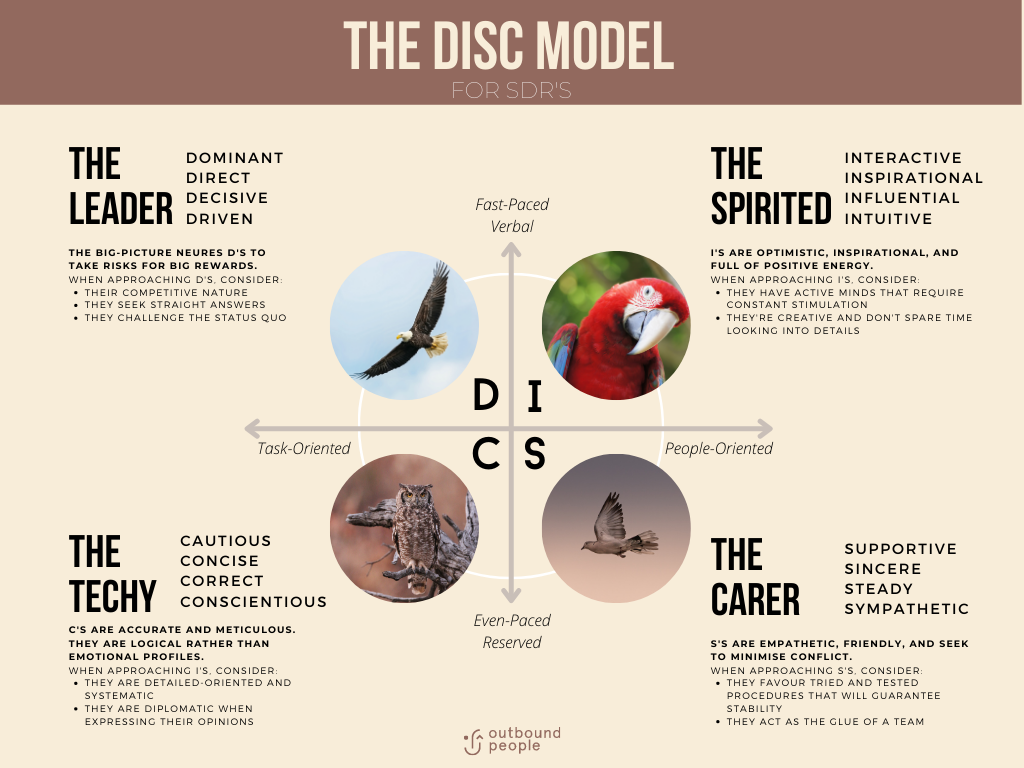Now, wouldn’t every SDR like to know how to close more qualified meetings? We bet this question is in the back of every SDR’s mind.
As always, this is not a straight answer. If only, right? Many variables come into play, but psychology is one you might be missing.
So let’s get to the point, shall we?
Understanding personality styles to close more qualified meetings
Have you ever heard of the DISC model? In a nutshell, this model differentiates 4 styles in which people think and behave/react. Each style will approach the same situation in their own way.
So, in other words, you shouldn’t always follow the saying “treat others how you want to be treated”. Instead, understand each style’s thought process and approach them the way it makes the most sense to them.
Let’s set an example. After calling a prospect, you’ve gained some insights on improvements that can be applied to the product you’re offering and the value proposition you’re communicating.
So you decide to let the product team know. Now, you may have noticed that they may ask you for detailed information, data backup, and may ask quite a few questions.
Your next step is to address your improvement ideas to the marketing team. They will have a completely different approach. Most likely, they won’t be as technical and they will be rather enthusiastic about new, fresh ideas.
What’s the bottom line? If you understand how each style behaves, you can approach each of them more effectively and make sure that your ideas are heard and considered.
The four styles
The human brain is divided into four quadrants. So it makes sense that there will be as many styles as brain quadrants.
Of course, humans are complex and it would be unusual that someone matched one style 100%. However, we will usually have a dominant style.

Let’s have a closer look at each style –
D’s – The Leader
Think of CEOs, natural leaders, the alphas.
D’s have dominant personalities. They are direct, take quick decisions, they are reactive. D’s are powerful, authoritative, and sometimes even intimidating. They look at the big picture, work towards big rewards, and take risks.
So when you’re dealing with a D, consider the following –
- Get straight to the point. Don’t waste too much time going into details. How can your solution help their company overall?
- React quickly. D’s have clear ideas and will probably ask specific questions, so be ready to give concise and relevant answers.
I’s – The Spirited
Think of your fellow salespeople or marketeers.
I’s are dynamic individuals with active minds. If you want to keep their attention, keep the conversation flowing. They’re optimistic and have lots of positive energy. They’re creative and enthusiastic, everything and anything can be achieved. I’s tend to be very talkative and spontaneous but may lack structure and miss details.
So this is how you should approach I’s –
- Be dynamic. If you want to keep their attention, keep the conversation in an upbeat manner.
- Encourage interaction. I’s can be quite talkative, so make the most out of it! It may help you gain insights that will be gold for your company.
- Be flexible. I’s are multitaskers, be ready to jump from one subject to another.
S’s – The Carer
Think of Customer Service.
S’s are supportive, empathic, and seek harmony. This means that, when in doubt, they’ll be inclined to bet for the safest option. They feel uncomfortable with disagreements or confrontations, they’ll be more likely to go with the flow. On the other hand, it might be hard for them to say ‘no’.
So here’s some tips when dealing with S’s –
- Be methodic. Follow a structured speech. The less they have to change to use your solution, the more likely they’ll be to move on through the pipeline.
- S’s prefer calm environments. Bring your energy down a level.
- Don’t put them on the spot.
C’s – The Techy
Think of your colleagues in Product, think of engineers.
C’s are detailed-oriented. They’re systematic and logical. They’re objective and will create and follow processes to ensure the results are achieved. C’s have high standards and are perfectionists, they take pride in their work.
Consider the following points when approaching C’s –
- Be detailed. Make sure you’ve prepared the call and will be able to respond technical and detailed questions. Be accurate with your answers.
- Be structured. Provide a logical sequence of information. Back up your explanations with facts.
- Take your time and give them time. Take your time to explain your product in detail and answer their many questions with accurate answers. You should also give them time to make a decision. They’ll analyse the product in depth, so it might take them some time to give you feedback.
The bottom line
If you understand which one of these 4 styles is dominant in your lead, you’ll be able to approach them more efficiently.
The DISC model has a wide variety of uses. If you’d like to learn how to use it other than to close more qualified meetings, follow this link to the Take Flight Learning webpage.
Find out when is the best time for cold calling. These the days and times of the week that have been proved to be the most successful.
Want to read more fresh content about the role of an SDR and sales teams? Check out more articles.
